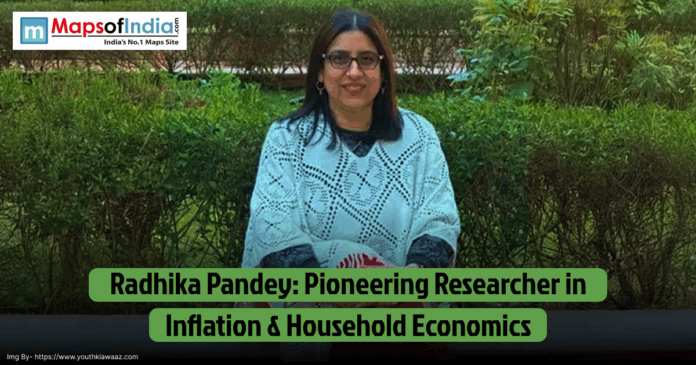Radhika Pandey was a well known economist. Her work shaped India’s economic policies. Her work mainly focused on inflation and household economics. As an associate professor at the National Institute of Public Finance and Policy (NIPFP), she influenced monetary policy and public finance. Her public engagement through clear writing inspired many. As a female economist her work has inspired many people and caused a great impact on Indian economic policies. Despite her passing on June 28, 2025, her legacy endures.
Early Life and Academic Journey
Radhika Pandey was born on December 18, 1978, in Varanasi, Uttar Pradesh. She grew up in an academic environment where she was encouraged to get an education. Her passion for economics emerged in the early stages of her life. In 1999 she completed her BA (Honours) in Economics from Banaras Hindu University. After that she pursued her further studies at Jai Narain Vyas University, Jodhpur. There she completed her MA in Economics in 2001. She later earned her PhD in Economics from the same university in 2006. Her academic journey blended economics with law. After completing her studies she started teaching at the National Law University in Jodhpur from 2005 to 2008. Her diverse background in education shaped her unique perspective on her work. She joined NIPFP in 2008. From there she began her influential career in economics and also as a policy maker. Her education helped her commitment to policy research.
Contributions to Inflation Targeting
Her work on inflation targeting was a transformation from every aspect. She co-authored a 2020 paper with Ila Patnaik titled “Four Years of the Inflation Targeting Framework.” This paper evaluated India’s inflation targeting since its adoption in 2016. The paper analyzed the Reserve Bank of India’s (RBI) 2 to 6% inflation target. This paper also highlighted successes in stabilizing prices. It also brought to light the challenges like food price volatility. Pandey emphasized clear communication to anchor expectations. Her work helped to guide RBI’s policies during the 2020 COVID-19 crisis. Her other paper published in 2020 “Moving to Inflation Targeting,” addressed the Impossible Trilemma. It explored balancing monetary policy. exchange rates and capital flows. Her work remains a cornerstone for Indian policymakers.
Research on Household Economics
Radhika Pandey’s research illuminated household consumption. Her 2021 paper “Consumption Baskets of Indian Households” compared CPI, CES, and CPHS data. It showed households allocate wealth to real estate and gold. This research helped to shape tax and financial policies. A 2019 paper with Renuka Sane explored tax breaks on savings. It shows the gaps in financial planning. Pandey has advocated for financial literacy programs in India. Her work connected micro level behaviours to macro outcomes. It informed public finance strategies. Her findings made economics relatable. Her work has bridged the gap between academic research and practical policy. Her work was the guiding principle in policy making during COVID-19. Her insights continue to guide household focused reforms.
Leadership in Policy Task Forces
Pandey led impactful policy initiatives. She coordinated the Ministry of Finance’s Task Force on Public Debt Management Agency in 2014. Her work streamlined debt management processes. She also contributed to the 2011 Financial Sector Legislative Reforms Commission which was chaired by Justice B.N. Srikrishna. These modernized financial regulations. She also served on the Working Group on Foreign Investment led by U.K. Sinha. Her expertise covered bond markets and capital controls. She also provided technical support to the Department of Economic Affairs. Her leadership turned research into policy. For her work she has always taken a collaborative approach for which her colleagues have always valued her. Her contributions strengthened India’s economic framework.
Public Engagement Through MacroSutra
Radhika Pandey was a well known public figure. She excelled at public communication. Since 2021 she has written the MacroSutra column for ThePrint. Her weekly articles and videos explained complex policies in easy words and were simple to understand. She covered difficult topics like inflation and fiscal policy to international trade in her videos. Her writing and video explaining style were clear and engaging. She made economics accessible and easy to all. She recorded her final MacroSutra video while she was hospitalized in June 2025. Her dedication to work was unwavering. Her colleagues praised her ability to connect. Her columns shaped public discourse and educated many more. They demystified economic concepts. Her work extended beyond academia. She inspired informed policy discussions.
Impact on Financial Sector Reforms
Pandey’s research transformed financial regulations. Her 2019 paper, “Evolution of Capital Controls on Foreign Institutional Investment,” provided a comprehensive dataset. This paper also analyzed restrictions on foreign investors. She explored trade-offs between price and financial stability. Her work with the 2011 Financial Sector Legislative Reforms Commission was pivotal. Her work helps to modernize India’s financial laws. She studied bond market dynamics. Her insights improved market efficiency. She was in support of privatizing state-owned banks. Her reforms strengthened India’s financial system. Her practical approach ensured a lasting impact on the Indian financial sector. Her work remains a reference for regulators.
Mentorship and Personal Legacy
Pandey was a mentor and role model for all her students. She guided young economists with kindness. She led a large team at NIPFP. Her interpersonal skills were exceptional. Her work colleagues described her as humble and supportive. She balanced work with family life. She prioritized her family despite her busy work. Evenings were reserved for her family. She deeply cared for her ailing mother. Her passing on June 28, 2025, due to liver failure shocked many. Tributes were showing her intellect and grace. Her ideas continue to inspire upcoming generations. Her values of service and humility endure. She showed that economics serves people. Her legacy lives through her students.
Conclusion
Radhika Pandey was a visionary economist. Her work on inflation and household economics shaped many of India’s policies. Her work influenced monetary frameworks and financial reforms. Her leadership in task forces drove change in many policies. Through MacroSutra she educated the public about economics and policy making. Her mentorship inspired future economists. Despite her passing in 2025 her research endures and is inspiring many great things. Papers on inflation targeting and household behaviour remain a vital part of her research. Her commitment to clarity and service set her apart from other economists. India’s economic landscape shows its contributions. Her legacy teaches us that economics is for people. Her ideas will guide future policymakers for years.




